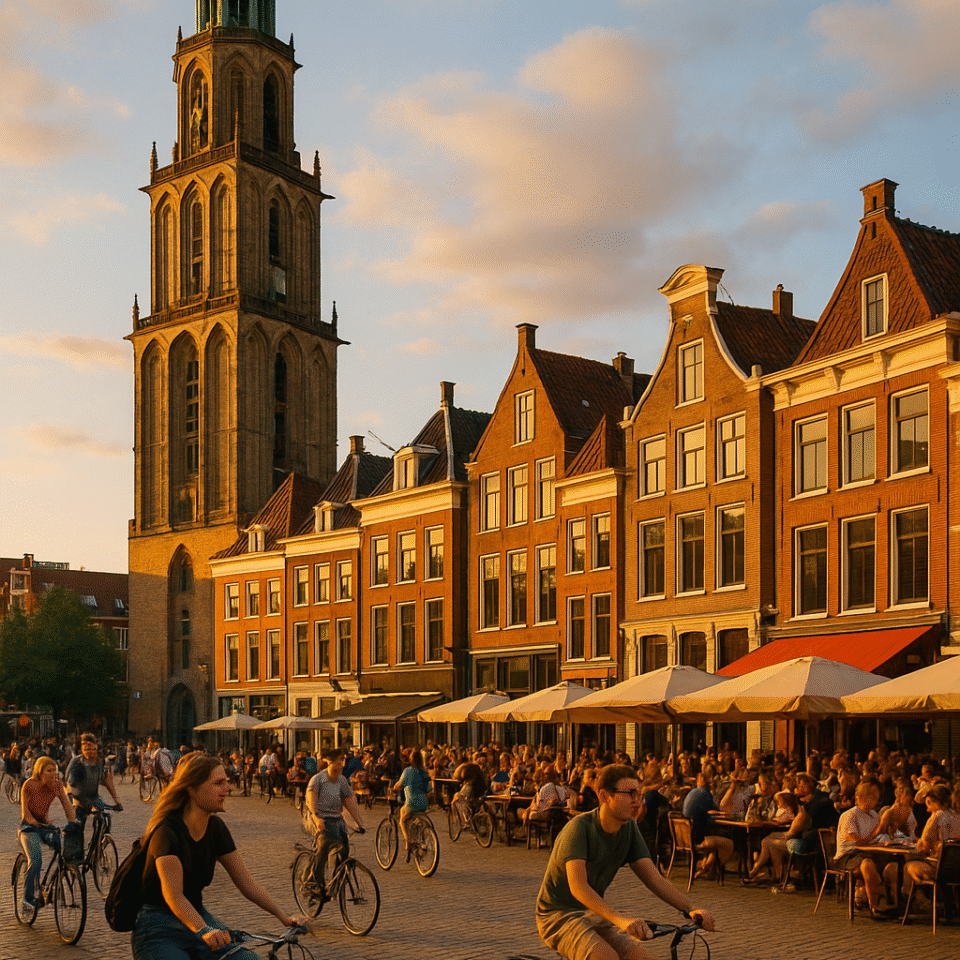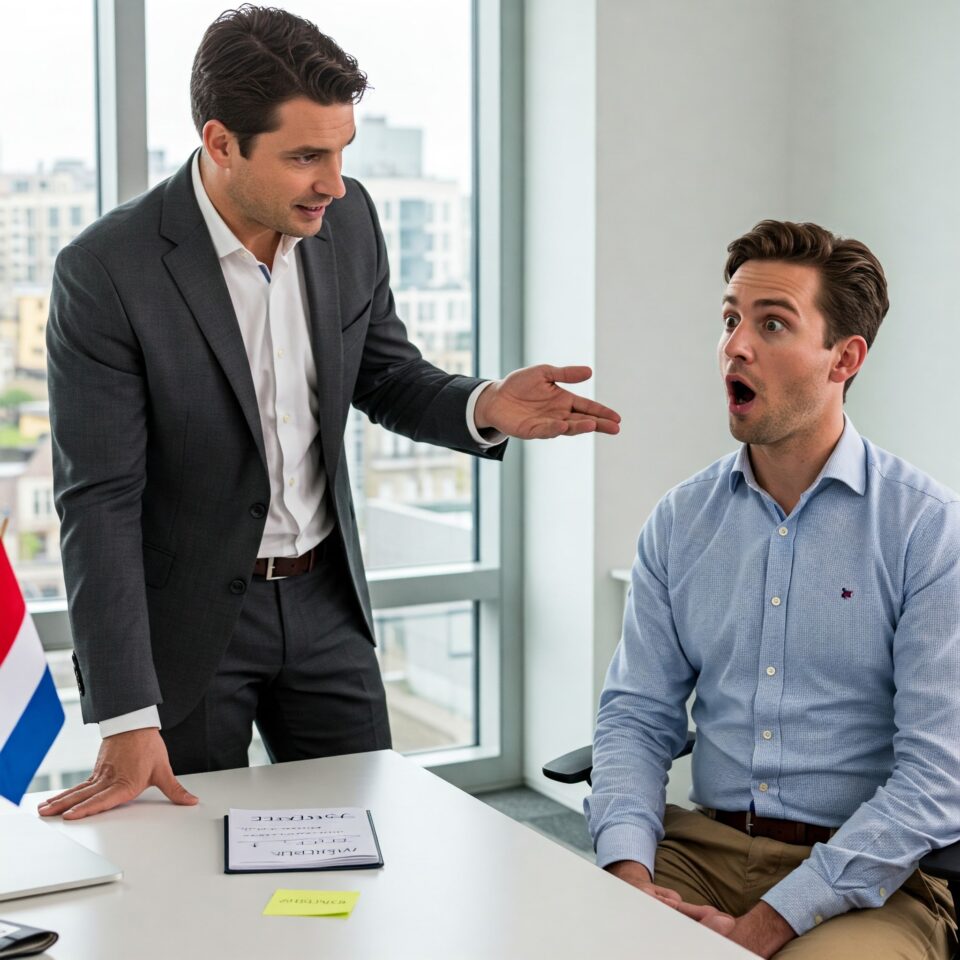When most Americans think of the Netherlands, Amsterdam’s iconic canals immediately come to mind. But venture just two hours north by train, and you’ll discover Groningen—a vibrant university city with medieval charm, cutting-edge culture, and a refreshingly authentic Dutch experience far from the tourist crowds. For American expats seeking to experience the Netherlands beyond the Randstad, this northern gem offers a perfect blend of history, innovation, and livability.
A Personal Connection
Before diving into what makes Groningen special, I should mention my own connection to this northern province. My ancestors hailed from the small village of Midwolda, located about 25 kilometers east of Groningen city in what is now the Oldambt municipality.
Midwolda has a fascinating history dating back to 1282, when it was first mentioned in records as “de Middewalda”—meaning “middle woods.” Like many villages in this region, Midwolda has had to adapt to the challenging relationship between the land and water. After the devastating All Saints’ Flood of 1570, the entire village relocated southward near a protective dike constructed in 1565. This resilience in the face of environmental challenges exemplifies the pragmatic spirit that still defines the Groningen province today.
Visiting Midwolda and the surrounding countryside gives you a glimpse into the region’s agricultural heritage, with its historic farms, picturesque Reformed church (built between 1738-1740), and the stately Ennemaborg estate with its surrounding moat. For Americans with Dutch ancestry from this region, exploring these small villages can be a deeply meaningful way to connect with your heritage.
City Profile: Why Groningen Deserves Your Attention
The Youngest City in the Netherlands
Despite being home to the country’s second-oldest university (founded in 1614), Groningen boasts the youngest population in the Netherlands. With over 60,000 students comprising about 25% of the city’s population, Groningen pulses with youthful energy that influences everything from its nightlife to its progressive policies.
For American expats, this creates a uniquely welcoming environment. The large international student community means English is widely spoken, making the initial transition period less intimidating than in more traditional Dutch cities. Meanwhile, the constant influx of young talent fuels innovation, ensuring the city remains forward-thinking despite its medieval roots.
A Compact, Car-Free Center
What strikes most American visitors immediately is Groningen’s pedestrian-friendly design. The historic city center is largely car-free, with an extensive network of bicycle paths making two-wheeled transport the preferred option for locals. In fact, over 60% of all journeys in Groningen are made by bicycle—a statistic that both impresses and intimidates newcomers from car-dependent American cities.
The compactness of the city center means you can easily walk from one side to the other in about 20 minutes. This human-scaled urban design creates a convivial atmosphere where chance encounters are common and neighborhood businesses thrive. The central Grote Markt (Great Market) and Vismarkt (Fish Market) squares serve as the beating heart of the city, hosting weekly markets and surrounded by cafés where locals linger for hours.
Cultural Riches Beyond Its Size
For a city of its relatively modest size (about 240,000 residents), Groningen offers cultural amenities that rival much larger urban centers. The Groninger Museum, housed in a postmodern building that dramatically rises from the canal opposite the train station, showcases contemporary art collections that attract international attention.
The city hosts Eurosonic Noorderslag, Europe’s premier showcase festival for emerging musical talent, and boasts a year-round calendar of events including theater performances at Stadsschouwburg, film festivals, and art exhibitions. For American expats accustomed to vibrant cultural scenes in cities like New York or Chicago, Groningen offers a surprisingly rich cultural landscape in a more manageable package.
Legendary Nightlife
Ask any Dutch person about Groningen, and they’ll likely mention its famous nightlife. Unlike most Dutch cities where bars close at 2 a.m., Groningen’s establishments can remain open until 5 a.m., with some closing as late as 7 a.m. This relaxed approach to closing times creates a distinctive nightlife culture where the evening unfolds at a leisurely pace.
Thursday nights are particularly lively, with students filling the bars around Grote Markt and Poelestraat. For American expats, this vibrant social scene provides ample opportunities to meet locals and fellow internationals in an informal setting—though the Dutch directness you’ll encounter might initially catch you off guard!
Practical Considerations for American Expats
Housing and Neighborhoods
As with most Dutch cities, housing is Groningen’s biggest challenge. The student population creates significant pressure on the rental market, particularly for furnished apartments suitable for expats. However, compared to Amsterdam or Utrecht, housing costs remain somewhat more reasonable.
Popular neighborhoods for internationals include:
- Schildersbuurt: Just west of the center, with beautiful architecture and a diverse community
- Oosterpoortbuurt: Known for its cultural venues and vibrant atmosphere
- Helpman: A greener, more residential area popular with families
- Noorderplantsoen: Adjacent to a lovely park, combining urban convenience with green spaces
Most American expats report that Facebook groups for internationals and platforms like HousingAnywhere are the most useful resources for finding accommodation.
Career Opportunities
While smaller than the Randstad cities, Groningen offers surprising career opportunities, particularly in specific sectors:
- Healthcare: The University Medical Center Groningen (UMCG) is one of the largest employers in the Netherlands and regularly recruits international talent
- Education: Both the University of Groningen and Hanze University of Applied Sciences employ English-speaking faculty and support staff
- Technology: A growing startup ecosystem, particularly in health tech and sustainability
- Energy: The province is leading the Dutch energy transition, with opportunities in renewable energy and the hydrogen sector
For Americans working remotely for U.S. companies, Groningen offers excellent digital infrastructure and co-working spaces like Launch Café at a fraction of Amsterdam’s costs.
Quality of Life Factors
In 2010, Groningen ranked second in an EU quality of life survey comparing 75 European cities—and it continues to excel in livability metrics. Americans frequently cite the following quality of life benefits:
- Clean air: Groningen has the cleanest air of all Dutch cities
- Green spaces: The city center is surrounded by parks, with natural areas easily accessible by bike
- Cultural amenities: World-class museums, theaters, and music venues
- Work-life balance: The northern Dutch approach emphasizes leisure time and family
- International atmosphere: A welcoming environment for expatriates from diverse backgrounds
While winters can be dark and rainy (as throughout the Netherlands), the long summer evenings and vibrant social scene more than compensate during the warmer months.
Connecting with the Local and Expat Communities
For Americans arriving in Groningen, several organizations facilitate integration:
- International Welcome Center North: Provides practical assistance with registration, taxes, and orientation
- ESN Groningen: Organizes events for international students and young professionals
- City Central: A meeting place for internationals with regular social and networking events
- Women Supporting Women in Groningen: An active community providing support and friendship
- The Monthly English Book Swap: Where internationals and Dutch people meet around a shared love of reading
Many American expats note that the international community in Groningen is particularly tight-knit compared to larger Dutch cities, making it easier to build meaningful connections despite being far from home.
Day Trips from Groningen
One of Groningen’s advantages is its position as a gateway to unique landscapes and experiences in the northern Netherlands:
- Schiermonnikoog: The least visited of the Dutch Wadden Islands, with pristine beaches and cycling paths
- Bourtange: A perfectly preserved star-shaped fortress town near the German border
- Lauwersmeer National Park: A bird-watching paradise created when the Lauwers Sea was closed off from the Wadden Sea
- Pieterburen: Home to the famous seal rehabilitation center and starting point of the Pieterpad hiking trail
- Midwolda and the Oldambt region: Explore the region’s agricultural heritage and historic estates
These destinations showcase the varied landscapes of the north—from coastal wetlands to forested areas—providing welcome contrast to urban life.
Final Thoughts: Is Groningen Right for You?
Groningen won’t be the perfect fit for every American expat. Those seeking the cosmopolitan intensity of Amsterdam or the international business environment of The Hague might find it too provincial. The weather can be harsh by Dutch standards, and direct international connections are limited compared to Randstad cities.
The Geographic Reality: Isolated Paradise or Too Far Removed?
The city’s location in the far north of the Netherlands is both Groningen’s charm and its primary drawback. At approximately two hours by train from Amsterdam, Groningen sits isolated from the Randstad—the densely populated western region containing Amsterdam, Rotterdam, The Hague, and Utrecht. This isolation has preserved Groningen’s unique character and kept housing costs relatively affordable, but it creates genuine challenges too.
For expats without cars (as many Americans in the Netherlands choose to live car-free), the distance can feel particularly limiting. Weekend trips to Amsterdam require planning, beach days at Scheveningen involve nearly three hours of travel each way, and reaching Amsterdam’s Schiphol Airport for international flights means building in significant buffer time. While Groningen does have its own airport, it offers limited connections primarily to European destinations.
I must confess that despite my ancestral connections to the region, the distance from the cultural and transportation hubs of the Randstad ultimately deterred me from settling in Groningen. For those who prioritize easy access to international connections, other major European cities, and the beaches of the western coast, the geographic isolation may simply be too great a compromise. As they say, “your mileage may vary.”
However, for Americans seeking an authentic Dutch experience with excellent quality of life, strong community connections, and affordability not found in the country’s more famous cities, Groningen offers a compelling alternative. The city combines traditional Dutch sensibilities with progressive thinking, historic architecture with cutting-edge design, and small-town accessibility with big-city amenities.
As one American expat resident put it: “Amsterdam is where tourists experience the Netherlands; Groningen is where you actually live it.”
For more information about moving to Groningen as an expat, visit the International Groningen portal and Here & Now Groningen, which offers community events and resources specifically for internationals.
About the author: As an American expat with ancestral connections to Midwolda in the Groningen province, I’ve developed a special appreciation for this northern region that balances tradition and innovation in a uniquely Dutch way.








